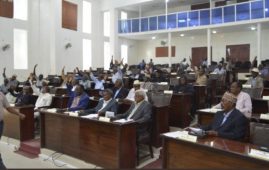Last week, the Ministry of Finance and Economic Development put out a "Brief note on the 2004 Ethiopian Fiscal Year National Accounts Estimate Series." This provided an assessment of the major activities of Ethiopia’s economy during the year and details of the country’s economic growth for the 2004 fiscal year (2011/12). The growth rate, based on the revised version of GDP accounting for the year, is estimated at 8.5%. This revision uses 2003 as the new base year for the calculations, but taking into account the previous year, the mean growth rate for the first 2 years of the Growth and Transformation Plan is calculated at 10%. Over the previous nine years (1996-2004 fiscal years) the government has registered an 11% annual average growth rate for GDP.
The estimate for the 2004 fiscal year on the newly set base year of 2003 fiscal year (2011/12) was made following the Government’s decision to change the base year. The previous computations were made using the fiscal year 1999/2000 as a yardstick. Fiscal year 2011/2012 will now be used for GDP accounting and for calculating the country’s GDP growth for the next five years.
The change in the national accounts’ methodology was made in order to reflect a wider range of new products and services in the equations in response to the newer economic activities and developments that have been taking place in the last decade and becoming part of business activities. There has also been progressive expansion, or downsizing, in different business sectors and various changes in the relative price of commodities. Another reason for the re-basing of the GDP calculation can be seen in the plan to bring about meaningful structural changes in the socio-economic framework on a short-to-medium term basis. The introduction of the new base year will also mean the GDP estimates will conform to the latest version of the UN Systems of National Accounts, last revised in 2008. Moreover it was necessary to make changes in the relative prices of commodities to portray the real growth and evolution of the economy more accurately.
The 2011/12 GDP estimates and figures for economic growth involved some 15 fixed and reshuffled sectors as well as newly identified sectors. Bajaj vehicles and mobile phones, floriculture and horticulture were among different sub-sectors added to the transport and communication and agriculture sectors and considered in the calculations. The result, according to the Ministry of Finance and Economic Development showed that Ethiopia’s economic growth for the 2004 fiscal year (2011/12), based on the revised version of GDP accounting, was 8.5%.
Among the major sectors, the annual growth rates of agriculture, industry and service were estimated to be 4.9%, 13.6% and 11.1% respectively; and their respective shares in the total GDP, estimated to be 737 billion birr, were 44%, 11% and 45% respectively. Investment volume rose by 6.7%, from 27.9% to 34.6%. With reference to GDP expenditure, consumption accounted for about 83.5% of the total, and the remaining 16.5% was registered as domestic saving. Of the 83.5% expenditure, the share of government was 7.0% and the remaining 76.5% was attributed to private consumption. The Ministry noted that the 16.5% domestic savings registered was a successful development, improving on the 15% set in the Growth and Transformation Plan. A significant increase was also registered in per capita income which grew from US$387 in 2010/11 to US$513 in 2011/12.
The increase registered in the agriculture sector was lower than the rate of the previous eight years which averaged 9.6%. This was the result of a relatively smaller growth in crop production, the backbone of the agriculture sector and which overall accounts for 30% the country’s GDP. This in fact was the main contributing factor to the relatively lower, though still-strong, total GDP growth registered in 2004. The re-basing of the benchmark to a more recent was expected to have an impact in the calculations for the year of implementation (2004) and thus affect the figures.
Although the latest calculation provides for only 8.5% growth, from the aggregate perspective, the Government has still managed to continue to achieve its double digit growth target. Over the last nine years (the 1996-2004 fiscal years) the government has registered an average 11% annual growth rate for the GDP. The average growth rate for the first 2 years of the Growth and Transformation Plan was also in double figures so the mean growth has been 10%. Nor can a growth of 8.5% be considered a failure, especially when compared to the average Sub-Saharan growth of 5.5%.
The proven track record of the Government’s effective utilization of resources, and the right mix of prioritized activities, will continue to make a positive contribution to sustaining double digit growth over the remaining 3 years of the Growth and Transformation Plan (2013-2015), and afterwards. Significant emphasis is continuing to be given both to productivity growth and to capital investment. The Government is simultaneously investing in the means of production as well as actual production for consumption. The Government’s mixture of policies and strategies is being successfully implemented. It has set priorities that have helped the country to maintain sustainable double-digit growth for almost a decade. This has involved the allocation of two-thirds of its revenue for capital investment. In sum, the sustainability of rapid growth has been a solid indication that the Government has put in place the right mix of policies and strategies that can deliver the rapid and sustainable growth which will allow for the achievement of the goal of becoming a middle income country by 2025. It will continue to pursue its activities on the basis of these priorities and maintain a balanced approach to growth of both capital investment and productivity.
In the remaining three years of the Growth and Transformation Plan, the Government is committed to continue to register average double-digit growth and to achieve all the Millennium Development Goals, including poverty reduction, as well as achieving its aims of expanding and improving its service provision. Most of the MDG goals, including a reduction in poverty by half to reach 27.2% in 2015, only require a consistent 7% growth. Given the average growth rate of 11% over the last eight years and the average for 10% for the first two years of the Growth and Transformation Plan, there should be little problem in reaching this figure and meeting the MDG goals.
The Government is also committed to ensuring the timely completion of the major projects including the construction of the Grand Ethiopia Renaissance Dam, the Gilgel Gibe III dam, the ten planned sugar factories, fertilizer factories and the railway and road projects. It is also committed to deliver on its target of increasing the role of the industrial sector to allow it to become the dominant element in GDP after the end of the Growth and Transformation Plan. The intent is to manage the structural shift from an agriculturally dominated GDP to industrially dominated economic growth by focusing mainly on expanding the industry sector and its share of total GDP without compromising continually increasing agricultural output both in quantity and quality.
****************
* Originally published on A Week in the Horn – February 15, 2013 issue, titled “Average 10% growth over the first two years of the GTP”. Items from A Week in the Horn are re-published here with a permission to do so. You may republish it with attrib
ution and no modification to its contents.
Check the archive for related posts.





